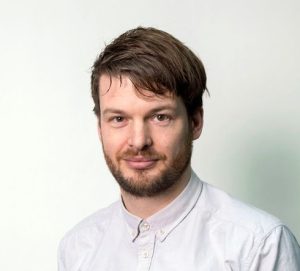Dutch journalist Seije Slager reached out to me in late October, a week after our 2021 Monarch Butterfly and Pollinator Festival.
The U.S. based reporter for the Amsterdam Daily, Trouw, was preparing a story on migration in the United States and would be traveling to Texas the following month. He said he was surprised to find in the course of his research that human migration is not the only type of migration occurring along the Interstate-35 corridor. Would I be up for meeting with him, and explaining the monarch butterfly migration?

Dutch journalist Seije Slager covers the U.S. for Trouw. –Courtesy photo
Of course!
As a first generation American, I consider my fascination with the monarch butterfly migration to be partially rooted in my family’s own immigration experience.
My parents immigrated from Germany in 1953 as Johannes and Hildegarde Maeckle. Their plan: “make a million bucks,” as my father used to say, then return to the Swabian city of Ulm.
But it didn’t work out that way. The welcoming environs and economic opportunities in Texas convinced my parents to stay in the U.S. My brother and I were both born in Jacksonville, Texas, and we both have made families and livings here. We have been back to Germany, but only to visit family.
Seije’s 1400-word article titled, “America’s most iconic migratory butterfly prefers to stay at home these days,” makes an interesting case for monarchs following my parents’ example.
The day I took Slager for a walk on the San Antonio River near my house on November 15, the temperature was 80 degrees. Milkweed and duranta were blooming profusely, as were the lantana and purple mistflowers. Monarchs were everywhere. So were Queen butterflies. Why would a creature endure the hardship of migration when everything needed to perpetuate the species is right here?
Since his series of articles was about migration in general, not just the monarch butterfly migration, I encouraged Slager to speak with Andy Davis, research scientist at the University of Georgia Odum School of Ecology, and Editor-in-Chief of Animal Migration.
As usual, Davis and I don’t agree on everything, but his perspective is needed and appreciated. He’s patently against anthropomorphizing monarch butterflies, and has said more than once that “migration is hard.”
Slager also spoke with San Antonio pollinator gardener Candy Roach who sets a great example for the community with her pollinator garden. Roach works hard to spread knowledge about suitable plants, water use, and the reduction of pesticides.
Read Slager’s article here, translated via Chrome.
Related posts:
- Candy Roach’s pollinator garden works overtime as bachelor pad for solitary bees
- Q & A with Andy Davis
- Popularity of pollinator gardens growing in areas prone to drought
- Planting a butterfly garden? Here’s tips on how to do it
- Mostly native butterfly garden outperforms lawn every time
- A year in the life of an urban butterfly garden
- Downtown River walk plot converts to pollinator garden, creature haven
- Converting your Lawn to a Butterfly Garden
- San Antonio becomes first National Wildlife Federation Monarch Champion city
- Tropical Milkweed: To Plant it or Not is No Simple Question
Like what you’re reading? Don’t miss a single post from the Texas Butterfly Ranch. Sign up for email delivery, like us on Facebook, or follow us on Twitter, @monikam.


Leave A Comment